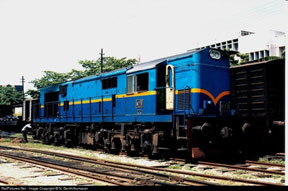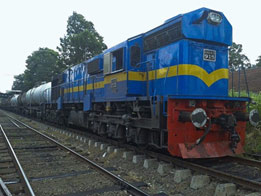|
Large and ponderous, they may lack the athletic good looks and flamboyance of the M2 to thrill the hearts of rail fans. Nor can they boast of theM2’s deep two stroke thunderto announce their imminent arrival from miles away or even split asunder the quiet of a warm Wanni night with a blast from triple Airchime horns. Yet in their inimitable way the M4s have established a quiet reputation as one of the most durable classes of locomotives on the Sri Lankan railway system. The fact that they continue to provide yeoman service still is a testimony to the excellence of their design and the standards of their manufacturer.
The M4 Class arrived in Sri Lanka in 1975, a total of fourteen locomotives in all. These diesel electrics were manufactured in Canada by MLW (now owned by Bombardier) to an American Locomotive Company (ALCO) design. They were a standard ALCO product adapted to Sri Lanka’s broad gauge. At the time of arrival they were the most powerful locomotives in Sri Lanka, their renowned ALCO 12-251C engines developing a massive 1,750hp. Their tractive effort was in excess of 50,000 lbs. Understandably, they were big locomotives, weighing around 94 tons and nearly 60 ft long, with a Co-Co type wheel arrangement. It is learnt that the Sri Lankan Railways sent an engineer over to MLW in Canada for inspection and witnessing the factory testspriorto shipping the locomotives. The locomotives came, but not the engineer, apparently he stayed behind and joined Canadian Pacific, or so they say!
On arrival they began taking over the running of crack expresses such as the “Yal Devi” and “UdarataMenike”, which train had hitherto been the preserve of the hydraulic W2s, already showing signs of impending and premature breakdown. Unfortunately for the M4s, the tight reverse curves of the Up Country Main Line did not take kindly to their immense wheelbase and weight. Soon it became apparent that track displacement was taking place, especially at the curves. Sadly, the M4s had to be withdrawn from the Up Country line and confined to the more gentle curves of the flat lands,which duties they handled admirably. It was indeed an impressive sight to see a huge M4 at speed, galloping down the parched Dry Zone plains with the “Yal Devi” in tow!
It is pertinent here to briefly explore the history of their manufacturers and design. The American Locomotive Company (ALCO), established in 1901, was a well-known steam locomotive builder in the US. They rose to the pinnacle of locomotive buildingwhen in 1941 they unearthed the colossal “Big Boy”, the largest steam locomotive ever built,weighing 550 tons and capable of hauling 4,000 ton freights unassisted over the Sherman Hills!By the mid-1930s, interest in diesel traction in the US was gaining momentum due to the pioneering work undertaken by the Electro Motive Division (EMD) of General Motors (GM). Although ALCO had produced a diesel locomotive in 1924 it was not until the late 1930s that ALCO entered the diesel locomotive field in earnest. In fact in the early 1940s ALCO produced the first “Road Switcher” type locomotive, the RS1. Unfortunately for ALCO, EMD took the Road Switcher concept to the next level with their revolutionary GP7 in 1949, sweeping all before them in the field of diesel locomotive building. Sadly, EMD’s subsequent almost monopolistic dominance, spelt the death knell for ALCO.
ALCO found they could not compete with the might of GM’s EMD and General Electric (GE), a late entrant to the diesel locomotive field. Finally in 1969, they closed down their Schenectady Locomotive Works, becoming defunct in the US. However, MLW in Canada, already a subsidiary of ALCO, continued the manufacture of ALCO locomotives even in to the 1980s, notwithstandinga take-over by Bombardier in 1975.
Fortunately for ALCO, despite their demise in the US, manufacturing of their designs had been established overseas, in Australia by Goodwin and in India by the Diesel Locomotive Works (DLW) in Varanasi. The Indian Railways (IR) owned DLW had been established in 1961 and turned out their first locomotives in 1964 to a then current ALCO design. DLW have not looked back since and today is one of the largest manufacturers of locomotives in the world. Admittedly, their locomotives may be to a now somewhat archaic ALCO design dating back several decades, but in recent times they have turned out state of the art AC drive locomotives in collaboration with EMD up to 5,000 hp in output. Nonetheless, ALCO locomotives produced by DLW have dominated the Indian diesel scene for over five decades. Of the five thousand odd diesel locomotives operating currently on the vast Indian railway network, one of the biggest and well run railway operations in the world, more than 60% are ALCO! Especially the WDM 2 Class, a rugged and reliable variant of ALCO’s DL560C design, one of the models developed by the now defunct US Company in the early 1960s for the world market, has continued to be the workhorse on Indian rail. The Class still continues to be built with over 2,700 units constructed. IR has selected this Class as the standard design for their broad gauge system.
| |
|
|
 |
| Class M8 DLW ALCO Locomotive |
|
|
It is then no surprise that the M4 was joined by their cousins from across the Palk Straits, the Class M8 in 1996. Even heavier than the M4 at 113 tons, they had the 16 cylinder version of the ALCO 251B engine producing a whopping 2,400 hp, the highest in Sri Lanka. With Co-Co wheel arrangement, again their weight and length precluded their use on the Up Country Main Line.Two of the eight locomotives received, designated Class M8A, came with the 12 cylinder engine offering 2,000 hp. |
| |
|
|
| In 2012 the M10 Class appeared, even heavier at 117 tons and more than 60 ft long, they remain the heaviest and longest diesel locomotive to run on the Sri Lankan system. Based on the DLW Class WDM 3A, and dual air/vacuum braking fitted, their ALCO 251C engines produce 2,300 hp. With a total of nine in the Class, used mainly on the recently re-laid Northern track, their enormous tractive effort approaching 60,000 lbs, could make short work of the heaviest twenty coach passenger trains on flat track. |
|
 |
| Class M10 DLW ALCO Locomotive |
|
| |
|
|
No doubt the Indian ALCOs have had their fair share of teething troubles. Maintenance charges such as corrosion, oil leaks, engine problems have been levelled against them, especially the M8s. It is common to see a grime and soot covered M8 clanging along belching black smoke at the head of a train, but then this is seen more as an issue of poor maintenance (perhaps not the black smoke, see later!) than of design or manufacture. These are a proven age old design, relatively unsophisticated without catastrophically failing electronics, hardy and able to put up with rough and tumble conditions! Their rugged low revving engines (maximum 1,000 rpm) could go on for decades. After all they are the backbone of the railways of our neighbours across the Straits!
It is a well-known fact amongst railway men that ALCO locomotives often throw out volumes of dense black smoke, so much so, that in some quarters of the US, they have been dubbed as “honourary steam locomotives”! This is a feature observed even with the relatively new M10s! The reason for this is “turbo lag”, at low rpm, until notch 4 or 5 on the throttle is selected, there is insufficient air produced by the turbocharger for proper combustion, the unburnt fuel passing off into the exhaust stack as soot and smoke. Once the turbocharger reaches speed and adequate air is provided, the problem eases off in the higher notches. It is learnt that DLW is working on a new design of turbo to overcome this phenomenon.
Despite being a dying breed, vintage ALCO locomotives are still going strong in many parts of the world, quite apart from India. In countries such as Australia, Mexico, Canada, parts of Africa and some corners of the US where they were born, several ALCOs are performing to this day,their relative simplicity and ruggedness lending them for ease of maintenance and operability, seemingly oblivious to the passage of years.
In Sri Lanka, of the thirty one ALCO locomotives, as far as is known, none have been scrapped or withdrawn, some even after four decades of intense and almost unnoticed service, unlike several other classes. No question here, they are the undisputableunsung heroes of Sri Lankan rail!
|